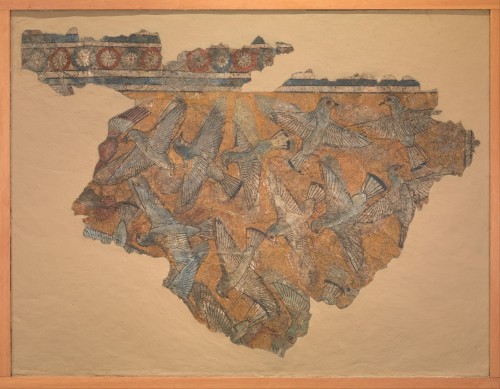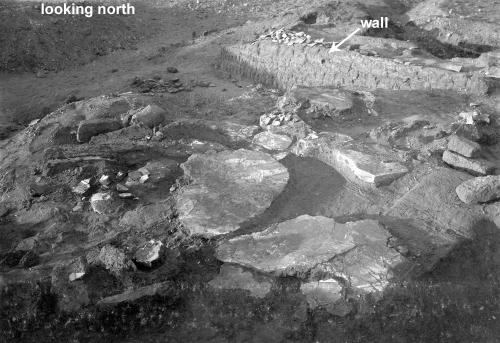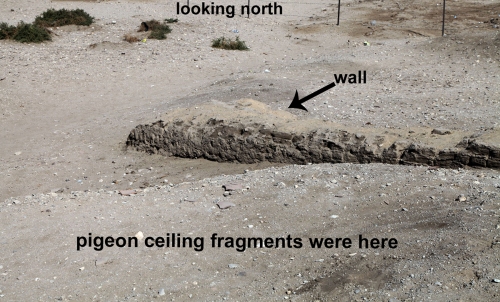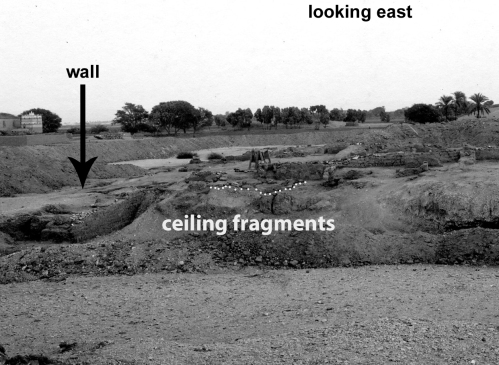https://imalqata.wordpress.com/2018/02/09/a-flock-of-pigeons/
On 02/09/18 06:40, iMalqata Blog wrote:
A Flock of Pigeons A Flock of Pigeons
Catharine Roehrig
When we first arrived in Luxor, I was looking at the old photographs of the work done in the King's Palace during the winter of 1910-1911 to see which ones might give us some information about the areas we are working on this year. At the end of the series there were a few photographs taken in 1912, during the following excavation season. Among these I found photos of ceiling fragments that were given to the Museum in that year's division of finds. In 1912, the Malqata excavation team, which included Ambrose Lansing, Hugh Evelyn-White, and Herbert Winlock, were working in an area they called the "western extension." This lay west of the King's Palace, across a well-worn pathway that is now the desert road which cuts north/south through the site. The first group of rooms was later called Ho W1 and a second, farther west, was called Ho W2 (house west 1 and 2). The relationship between these "houses" is unclear because a wadi (dry river bed) has washed out the area between them, but they are now interpreted as a single structure called the Middle Palace.

Ceiling fragment depicting pigeons startled into flight. The end of a duck's wing is visible in the upper left. Rogers Fund (12.180.257).
The ceiling fragments in question depict flying birds. One section is almost entirely composed of pigeons (12.180.257), with the edges of ducks' wings indicating that there were other types of birds in the scene as well. The second section, smaller and more fragmentary, depicts pintail ducks. All of the birds are moving wildly as though startled into flight.
Both of these ceiling fragments are identified on their accession cards as coming from the King's Palace, and similar ceiling paintings were found there by Robb de Peyster Tytus and Percy Newberry, who excavated there a decade before The Met's Egyptian Expedition. However, thanks to the old photographs, it's now possible to place them in one of the rooms in the Ho W1.

Photograph taken in 1912 showing the pigeon fragments where they fell. Note the wall in the background.

The same wall today partially covered with a century of wind- and water-borne debris
One of the photos shows the pigeon section of the ceiling where it lay on the ground. The photographic context is rather narrow, but there is a wall in the upper right of the photo. This wall, although now partially buried in wind-blown debris, is still recognizable today.

Photo taken in 1912 showing the position of the pigeon fragments. The sawhorses behind the fragments were part of a glass-topped table used to reconstruct the fragments.
In the second photograph, taken from HoW 2 looking east at Ho W1, the fragments are also visible. Behind the fragments are two sawhorses that would hold a large sheet of glass. Several of these glass tables had been used the previous season to facilitate the reconstruction of ceiling paintings. The fragments were placed face down on the glass and were then moved into position. When the reconstruction was as complete as possible, plaster of Paris was poured over the back to secure them for travel and display.
The sections of ceiling that came to New York are now displayed on the south wall of Egyptian gallery 119.
-- Sent from my Linux system.
No comments:
Post a Comment